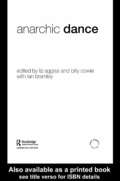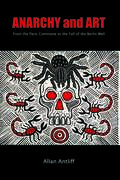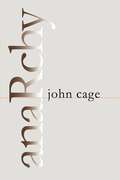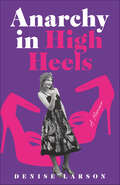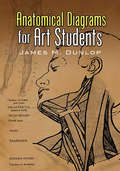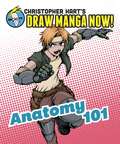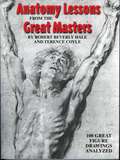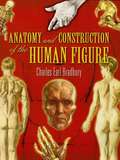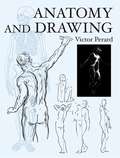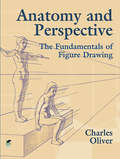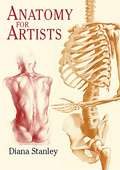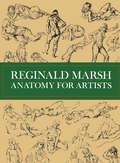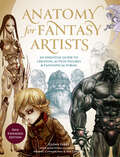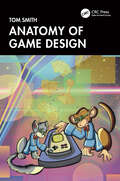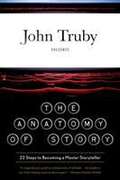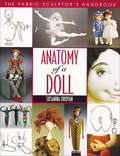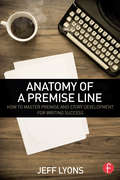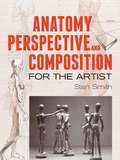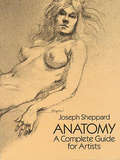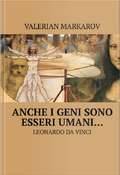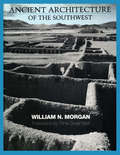- Table View
- List View
Anarchic Dance
by Liz Aggiss Billy Cowie Ian BramleyLiz Aggiss and Billy Cowie, known collectively as Divas Dance Theatre, are renowned for their highly visual, interdisciplinary brand of dance performance that incorporates elements of theatre, film, opera, poetry and vaudevillian humour. Anarchic Dance, consisting of a book and DVD-Rom, is a visual and textual record of their boundary-shattering performance work. The DVD-Rom features extracts from Aggiss and Cowie's work, including the highly-acclaimed dance film Motion Control (premiered on BBC2 in 2002), rare video footage of their punk-comic live performances as The Wild Wigglers and reconstructions of Aggiss's solo performance in Grotesque Dancer. These films are cross-referenced in the book, allowing readers to match performance and commentary as Aggiss and Cowie invite a broad range of writers to examine their live performance and dance screen practice through analysis, theory, discussion and personal response. Extensively illustrated with black and white and colour photographs Anarchic Dance, provides a comprehensive investigation into Cowie and Aggiss’s collaborative partnership and demonstrates a range of exciting approaches through which dance performance can be engaged critically.
Anarchy and Art
by Allan AntliffOne of the powers of art is its ability to convey the human aspects of political events. In this fascinating survey on art, artists, and anarchism, Allan Antliff interrogates critical moments when anarchist artists have confronted pivotal events over the past 140 years. The survey begins with Gustave Courbet's activism during the 1871 Paris Commune (which established the French republic) and ends with anarchist art during the fall of the Soviet empire. Other subjects include the French neoimpressionists, the Dada movement in New York, anarchist art during the Russian Revolution, political art of the 1960s, and gay art and politics post-World War II. Throughout, Antliff vividly explores art's potential as a vehicle for social change and how it can also shape the course of political events, both historic and present-day; it is a book for the politically engaged and art aficionados alike. Allan Antliff is the author of Anarchist Modernism.
Anarchy: New York City–January 1988
by John CageWinner of the Association of American University Presses (AAUP) Book, Jacket, and Journal Show – Best Scholarly Typography (2002)"That government is best which governs not at all; and when men are prepared for it, that will be the kind of government which they will have." This quote from Henry David Thoreau's Essay on Civil Disobedience is one of thirty quotations from which John Cage created Anarchy, a book-length lecture comprising twenty mesostic poems. Composed with the aid of a computer program to simulate the coin toss of the I Ching, Anarchy draws on the writings of many serious anarchists including Emma Goldman, Peter Kropotkin, and Mario Malatesta, not so much making arguments for anarchism as "brushing information against information," giving the very words new combinations that de-familiarize and re-energize them. Now widely available of the first time, Anarchy marks the culmination of Cage's work as a poet, composer and as a thinker about contemporary society.
Anarchy in High Heels: A Memoir
by Denise LarsonAnarchy in High Heels is not a state of dress; it’s a state of mind.A San Francisco porno theater might be the last place you’d expect to plant the seed of a feminist troupe, but truth is stranger than fiction.In 1972, access to birth control and a burn-your-bra ethos were leading young women to repudiate their 1950s conservative upbringing and embrace a new liberation. Denise Larson was a timid twenty-four-year-old actress wannabe when, at an after-hours countercultural event, The People’s Nickelodeon, she accidentally created Les Nickelettes. This banding together of ¬¬like-minded women with an anything-goes spirit unlocked a deeply hidden female humor. For the first time, Denise allowed the suppressed satirical thoughts dancing through her head to come out in the open. Together with Les Nickelettes, which quickly became a brazen women’s lib troupe, she presented a series of feminist skits, stunts, and musical comedy plays. In 1980, The Bay Guardian described the group as “nutty, messy, flashy, trashy, and very funny.”With sisterhood providing the moxie, Denise took on leadership positions not common for women at the time: playwright, stage director, producer, and administrative/artistic director. But, in the end, the most important thing she learned was the power of female friendship.
Anatomical Diagrams for Art Students
by James M. DunlopAny artist wishing to practice figure drawing or to understand the body's movement will do well to study the interaction of muscles with bone structure. This timeless introduction to human anatomy combines art and science, focusing on realistic depictions of the skeleton's impact on the external form and the attachments of the muscular system.More than 70 black-and-white illustrations show the positions and names of muscles and bones. Clear and accurate, the diagrams cover everything from the bones and muscles in the neck, head, trunk, limbs, hand, and foot to details of the face. Artists at every level of experience will find this volume an indispensable reference.
Anatomy 101: Christopher Hart's Draw Manga Now! (Christopher Hart's Draw Manga Now!)
by Christopher HartFocusing on anatomy, one of the fundamentals of drawing manga characters, Anatomy 101 teaches readers how to accurately draw the manga figure. From lessons on muscular and skeletal structure, arms, hands, and feet to poses and movement, this book covers everything readers need to go from manga fans to manga artists. After an introduction to these elements, readers will have a chance to follow along Hart's in-depth step-by-steps, and will even be invited to draw on their own, right in the book's pages.
Anatomy Lessons From the Great Masters
by Robert Beverly Hale Terence CoyleThis classic book, whose foremost author was one of the great artistic anatomy teachers of the twentieth century, is an invaluable instructor and reference guide for any professional, amateur, or student artist who depicts the human form. Revealing the drawing principles behind one hundred inspiring masterpieces, the book presents work by Leonardo, Michelangelo, Rubens, Raphael, Titian, Rembrandt, and other greats. These superb portrayers of figures knew that the secret of drawing them was seeing how underlying bone and muscle structures mold the body's surface forms. Readers are shown how to learn from these great examples as the authors guide them through all the steps they would take in a life class or studio working with live models.From the Trade Paperback edition.
Anatomy Lessons from the Great Masters
by Robert Beverly Hale Terence CoyleThis classic book, whose foremost author was one of the great artistic anatomy teachers of the twentieth century, is an invaluable instructor and reference guide for any professional, amateur, or student artist who depicts the human form. Revealing the drawing principles behind one hundred inspiring masterpieces, the book presents work by Leonardo, Michelangelo, Rubens, Raphael, Titian, Rembrandt, and other greats.
Anatomy and Construction of the Human Figure
by Charles Earl BradburyTo draw or paint human figures truly, an artist must have as much understanding of bones and muscles as of form. This beautiful guide by a respected artist and teacher provides that knowledge. Realistic plates of bones and muscles show form and function, while full-color images make graphic distinctions between bone, muscle, and tendon. Drawings throughout the book emphasize fundamentals of anatomy and show simple methods of building the forms.Author Charles Earl Bradbury (1888-1967) takes a two-part approach in this book. The first part features a self-contained treatment of the bones of the skeleton and how they relate to the body's outline and muscle masses. The second focuses on muscles and their actions, showing how they are constructed and how they look in the human form. Male and female structures are compared and contrasted throughout the text. Designed specifically for classroom use, this volume is also a priceless reference.
Anatomy and Drawing
by Victor PerardThis instructive book presents excellent annotated line drawings of anatomical structure for the beginning artist. Explaining the subject in simple terms and with an extensive series of dynamic illustrations, the author identifies parts of the body and demonstrates a wide array of physical activities through his sketches. Following notes on proportion and drawing, chapters cover the human skeleton, head and neck, torso, arm, hand, leg, foot, and musculature. Numerous illustrations depict various views of these structures, movements of the human figure, as well as changes in the relative proportions of features at different ages. One of the best books in its field, Anatomy and Drawing helps demystify a complex subject by enabling students to visualize the muscles and bones under the skin, and covers just about everything a beginner needs to know about drawing the human anatomy.
Anatomy and Perspective: The Fundamentals of Figure Drawing (Dover Art Instruction)
by Charles OliverArtists of classical Greece and the Renaissance were highly aware of the complexity and great beauty of the human figure, and strove in their artwork to depict the ideal form. This book by an experienced twentieth-century art teacher covers two fundamentals of figure drawing that were equally important to masters of earlier eras -- anatomy and perspective, subjects that seldom receive a thorough treatment within the same book. Carefully addressing both topics, the text suggests ways to convey the structure and functions of the human figure, covers elementary principles of drawing, and considers the use of light and shadow. Also discussed are aspects of measurement and the application of such simple forms as the cube, cylinder, and sphere in representing parts of the human body.In describing the relationship between anatomical features and surface form, the chapters on anatomy include drawings of the bones and muscles of the trunk, upper and lower limbs, and the head and its prominent aspects. A final section focuses on accessories, such as eyeglasses and clothing -- items which, when worn, virtually become part of the figure's anatomy.Clearly and concisely written, Anatomy and Perspective will be an important addition to the personal library of anyone interested in drawing the human figure.
Anatomy for Artists
by Diana StanleyConcise and uniquely organized, this outstanding guide teaches the essentials of anatomical rendering. Author Diana Stanley presents numerous illustrations and instructions covering the key aspects of anatomy, without the distractions of unnecessarily extensive technical details that many art students find discouraging. Four major sections constitute the book, with studies of the trunk, the head and neck, the upper limb, and the lower limb. Each section features full coverage of the skeleton, the muscles, and their surface forms. The emphasis throughout is on relating anatomical structure to the actual surface appearance of the body, both at rest and in motion. Sixty-four exceptionally clear and instructive illustrations include diagrams of skeleton and muscle structure, as well as superb examples of figure drawing. This affordably priced and easy-to-reference manual represents an invaluable addition to the library of every artist -- student and professional.
Anatomy for Artists (Dover Anatomy for Artists)
by Reginald MarshPortraying the living human form, not only with anatomical accuracy, but so that it conveys motion, emotion, and vitality is one of the greatest challenges faced by the artist. In the studies in this volume, famous artist and art instructor Reginald Marsh brought his genius to bear on the complex problem of life drawing. Delving into the work of the great masters (Michelangelo, Leonardo, Raphael, Rubens, Poussin, Dürer, Holbein, and others), Marsh simplified, abstracted, adapted, and reinterpreted their work into a collection of drawings both immensely interesting and instructive to the practicing artist and the student. The 209 pages of drawings in this volume show the human body in a wide variety of positions, viewed from many different angles. Marsh directs special attention to those angles, aspects, and physical positions which are the most difficult to portray. His great talent, coupled with a rare ability to instruct others (Marsh taught at the Art Students League for many years) gave him unusual sensitivity to the concerns of the artist in life drawing: his concise commentary on the drawing points up the problems addressed in each -- tone, movement, proportion, composition, etc. The front, side, back, head, arms and hands, legs and feet, and full figure drawings are all included. A separate section on the problems of proportion explores 7, 7 1/2, and 8 head schemes, providing an unusually workable and lucid treatment of the topic for the practicing artist. The body and parts of the body are drawn in skeleton, tissue and muscle, major bone structure, and as they appear in life. Marsh studied medical anatomy as well as the work of the great medical artists in order to perfect his knowledge of human anatomy. All of the hundreds of drawings, figures, and details of this volume have been excellently reproduced in this edition. The last 95 drawings in the book are all original studies by Marsh, never before published in book form. These casual, light-hearted drawings (mostly of female nudes) illustrate both Marsh's seemingly easy mastery of the techniques of life drawing, and his characteristic lusty, Rubenesque style. Because they are so distinctly in his own style, these drawings highlight the great scope and knowledgeability he has shown in the earlier instructive studies. Those who know and admire Marsh as an artist, as well as anyone who wishes to learn to draw from life, will find this volume indispensable.
Anatomy for Fantasy Artists: An Essential Guide to Creating Action Figures & Fantastical Forms
by Glenn FabryAn indispensable guide for anyone interested in improving and developing their fantasy art figures. Start with the basics of human anatomical drawing and musculature, and then learn ways to distort, develop, and transform the human figure, giving it features that range from monstrous or magical to super-agile or larger than life.
Anatomy of Game Design
by Tom SmithPeople have played games forever, but it’s only in the past few decades that people really started thinking about what games are, how they work, and how to make them better.Anatomy of Game Design takes some of the most popular and beloved games of all time and dissects them to see what makes them tick. By breaking down the systems and content of each game, the underlying systems of game design are laid bare.Eight games are analyzed – including Settlers of Catan; Centipede; Candy Crush Saga; Papers, Please; Magic: The Gathering; and more – each representing a different genre or era of game design. Each game is discussed in detail, using the same methods for each game. What are the verbs of the game that give the player agency? How do those verbs fit together to form a core loop that makes the game engaging? What are the systems that power the gameplay? What is the larger flow that makes the game interesting over and over again?Each game is then used as an example to tie back to one or more larger topics in game design, such as systems design, randomness, monetization, game theory, and iterative approaches to game development.Key Features: Uses well-known games to provide specific, discrete examples of broader game design theory Discusses eight popular games using the same methodology to allow comparison of different types of games Includes both high-level theory and academic perspective and practical, real-world guidance from a working game designer who has created these games for commercial release Provides clear direction for deeper inquiry into game design or related fields such as psychology, anthropology, game development, or systems thinking
Anatomy of Paradise Hawaii and the Islands of the South Seas
by J. C. FurnasEmbark on an enchanting journey through the idyllic islands of the Pacific with J. C. Furnas's Anatomy of Paradise: Hawaii and the Islands of the South Seas. This captivating travel narrative offers a rich and detailed exploration of the cultures, landscapes, and histories of Hawaii and the South Sea Islands, capturing the essence of these paradisiacal destinations.Furnas, a skilled writer and keen observer, provides readers with a comprehensive account of his travels through some of the world's most breathtaking and remote locales. From the volcanic majesty of Hawaii to the serene beauty of Tahiti and Fiji, Anatomy of Paradise vividly portrays the natural splendor and unique cultural heritage of each island.The book delves into the complex history of the Pacific Islands, tracing their journey from ancient Polynesian navigators to encounters with European explorers and the impact of colonialism. Anatomy of Paradise is not just a travelogue; it is an exploration of the human spirit and its connection to these enchanting lands. Furnas highlights the resilience, traditions, and daily lives of the islanders, providing a respectful and empathetic portrayal of their societies. His engaging prose brings to life the rhythms of island life, from traditional ceremonies and dances to the challenges of modernity.This book is an essential read for travel enthusiasts, historians, and anyone fascinated by the Pacific Islands. Furnas's evocative storytelling and thorough research create a vivid tapestry of the islands, making Anatomy of Paradise a timeless tribute to one of the world's most captivating regions.Join J. C. Furnas on this unforgettable journey and experience the magic, mystery, and beauty of Hawaii and the Islands of the South Seas through the eyes of a masterful storyteller.
Anatomy of Story: 22 Steps to Becoming a Master Storyteller
by John TrubyJohn Truby is one of the most respected and sought-after story consultants in the film industry, and his students have gone on to pen some of Hollywood's most successful films, including Sleepless in Seattle, Scream, and Shrek. The Anatomy of Story is his long-awaited first book, and it shares all his secrets for writing a compelling script. Based on the lessons in his award-winning class, Great Screenwriting, The Anatomy of Story draws on a broad range of philosophy and mythology, offering fresh techniques and insightful anecdotes alongside Truby's own unique approach to building an effective, multifaceted narrative.
Anatomy of a Doll: The Fabric Sculptor's Handbook
by Susanna Oroyan&“At last! A complete book on doll design and soft sculpture has been written.&” —Virginia Robertson, designer and publisher Master dollmaker Susanna Oroyan gives you the definitive book on fabric sculpting. Anatomy of a Doll is packed with an abundance of exquisite photographs that capture the best work from dollmakers today. Detailed step-by-step illustrations for an incredible variety of cloth dolls are included for you to create any type of cloth doll imaginable. Many methods of doll construction are covered so that beginning and professional dollmakers have a handy answer book. Beginners will find the book a practical guide that examines techniques for making all kinds of dolls. The more experienced dollmaker will discover an abundance of new ideas and techniques never before found in one book. Anatomy of a Doll shows you everything from bending wire to cutting cloth, which will allow you to create your own original dolls!&“[Enjoy] this book as a peerless museum guide, as a user&’s manual of the inventive hand and mind, and as a parable of science.&” —Scientific American&“It&’s finally happened—the cloth doll book that says it all! Thank you Susanna—the table is set, the banquet is prepared!&” —Elinor Peace Bailey, author of Storytelling with Dolls&“Here is all the information you need—written in Susie&’s friendly, casual style.&” —Cary Raesner, editor of Doll World
Anatomy of a Park: Essentials of Recreation Area Planning and Design (Third Edition)
by Donald J. MolnarThis book lays bare the essentials of park design. Although it may serve as an overview or refresher for park designers, this book is written primarily for nondesigners such as lay members of park boards, park directors and superintendents, recreation leaders, and anyone directly affected by what a designer proposes for the development of parklands.
Anatomy of a Premise Line: How to Master Premise and Story Development for Writing Success
by Jeff LyonsIf a story is going to fail, it will do so first at the premise level. Anatomy of a Premise Line: How to Master Premise and Story Development for Writing Success is the only book of its kind to identify a seven-step development process that can be repeated and applied to any story idea. This process will save you time, money, and potentially months of wasted writing. So whether you are trying to write a feature screenplay, develop a television pilot, or just trying to figure out your next story move as a writer, this book gives you the tools you need to know which ideas are worth pursuing. In addition to the 7-step premise development tool, Anatomy of a Premise Line also presents a premise and idea testing methodology that can be used to test any developed premise line. Customized exercises and worksheets are included to facilitate knowledge transfer, so that by the end of the book, you will have a fully developed premise line, log line, tagline, and a completed premise-testing checklist. Here is some of what you will learn inside: Ways to determine whether or not your story is a good fit for print or screen Case studies and hands-on worksheets to help you learn by participating in the process Tips on how to effectively work through writer’s block A companion website (www.routledge.com/cw/lyons) with additional worksheets, videos, and interactive tools to help you learn the basics of perfecting a killer premise line
Anatomy, Perspective and Composition for the Artist (Dover Art Instruction)
by Stan SmithSplendid color illustrations by a distinguished painter and teacher highlight this volume of practical instruction in the foundations of art. Perfect for intermediate-level and advanced artists wishing to take their work to the next level, this manual combines detailed anatomy studies with guidance in the principles and practice of perspective and the art of composition.Author Stan Smith interprets the traditions of European art from the Renaissance onward, providing step-by-step diagrams that develop students' understanding and familiarity with concepts and techniques. Technical and expressive qualities receive equal emphasis. In addition to its value as a source of instruction, this book also functions as an essential reference.
Anatomy: A Complete Guide for Artists (Dover Anatomy for Artists)
by Joseph SheppardIn this superb guidebook, a skilled practitioner of figure drawing demonstrates how to achieve mastery of anatomy through careful, knowledgeable articulation of the muscles and bones lying beneath the skin. Joseph Sheppard's concise instructions have been carefully integrated with over 250 halftone illustrations and over 180 line drawings to lead artists one step at a time through the techniques required in rendering human anatomy convincingly.The opening chapter of the book presents the special techniques involved in mastering human proportion.The chapters that follow each deal with a separate part of the body: the arm, hand, leg, foot, torso, head, and neck (with special coverage of facial features and expressions) and the complete figure.Each of these chapters follows a basic format that combines drawings of the featured body portion from many different angles, coverage of the specific bones and muscles involved, a table of muscle origins and insertions, and coverage of surface anatomy and depictions of the body part in a variety of positions. Joseph Sheppard taught drawing, anatomy, and painting for many years at the Maryland Institute of Art. He is the author of several books of art instruction, and the recipient of a number of distinguished prizes and awards for his sculptures and other works of art, many of which are in the collections of art museums across America.
Anche i geni sono esseri umani: Leonardo da Vinci
by Valerian MarkarovVisse un uomo straordinario, il cui nome è noto ad ognuno: Leonardo d Vinci. La sua vita fu piena di misteri, vittorie e sconfitte, tragedie e amore. Questo appassionante romanzo, basato su avvenimenti storici, ci trasporta nell'Italia dell'epoca del Rinascimento e i suoi personaggi — papi e cardinali, re e condottieri, politici e artisti — sono presenti come persone vive. Nel libro sono toccati temi che possono ferire i sentimenti di una determinata parte di persone. Leggete la stupefacente storia della vita di un uomo bellissimo, una vita divenuta leggenda…
Ancient Architecture of the Southwest
by William N. Morgan<p>During more than a thousand years before Europeans arrived in 1540, the native peoples of what is now the southwestern United States and northern Mexico developed an architecture of rich diversity and beauty. Vestiges of thousands of these dwellings and villages still remain, in locations ranging from Colorado in the north to Chihuahua in the south and from Nevada in the west to eastern New Mexico—a geographical area of some 300,000 square miles. This study presents a comprehensive architectural survey of the region. Professionally rendered drawings comparatively analyze 132 sites by means of standardized 100-foot grids with uniform orientations. Reconstructed plans with shadows representing vertical heights suggest the original appearances of many structures that are now in ruins or no longer exist, while concise texts place them in context.<p> <p>Organized in five chronological sections that include 132 professionally rendered site drawings, the book examines architectural evolution from humble pit houses to sophisticated, multistory pueblos. The sections explore concurrent Mogollon, Hohokam, and Anasazi developments, as well as those in the Salado, Sinagua, Virgin River, Kayenta, and other areas, and compare their architecture to contemporary developments in parts of eastern North America and Mesoamerica. The book concludes with a discussion of changes in Native American architecture in response to European influences. Written for a general audience, the book holds appeal for all students of native Southwestern cultures, as well as for everyone interested in origins in architecture. In particular, it should encourage younger Native American architects to value their rich cultural heritage and to respond as creatively to the challenges of the future as their ancestors did to those of the past.<p>
Ancient Architecture of the Southwest
by William N. MorganDuring more than a thousand years before Europeans arrived in 1540, the native peoples of what is now the southwestern United States and northern Mexico developed an architecture of rich diversity and beauty. Vestiges of thousands of these dwellings and villages still remain, in locations ranging from Colorado in the north to Chihuahua in the south and from Nevada in the west to eastern New Mexico--a geographical area of some 300,000 square miles. This study presents a comprehensive architectural survey of the region. Professionally rendered drawings comparatively analyze 132 sites by means of standardized 100-foot grids with uniform orientations. Reconstructed plans with shadows representing vertical heights suggest the original appearances of many structures that are now in ruins or no longer exist, while concise texts place them in context. Organized in five chronological sections that include 132 professionally rendered site drawings, the book examines architectural evolution from humble pit houses to sophisticated, multistory pueblos. The sections explore concurrent Mogollon, Hohokam, and Anasazi developments, as well as those in the Salado, Sinagua, Virgin River, Kayenta, and other areas, and compare their architecture to contemporary developments in parts of eastern North America and Mesoamerica. The book concludes with a discussion of changes in Native American architecture in response to European influences. Written for a general audience, the book holds appeal for all students of native Southwestern cultures, as well as for everyone interested in origins in architecture. In particular, it should encourage younger Native American architects to value their rich cultural heritage and to respond as creatively to the challenges of the future as their ancestors did to those of the past. During more than a thousand years before Europeans arrived in 1540, the native peoples of what is now the southwestern United States and northern Mexico developed an architecture of rich diversity and beauty. Vestiges of thousands of these dwellings and villages still remain, in locations ranging from Colorado in the north to Chihuahua in the south and from Nevada in the west to eastern New Mexico. This study presents the most comprehensive architectural survey of the region currently available. Organized in five chronological sections that include 132 professionally rendered site drawings, the book examines architectural evolution from humble pit houses to sophisticated, multistory pueblos. The sections explore concurrent Mogollon, Hohokam, and Anasazi developments, as well as those in the Salado, Sinagua, Virgin River, Kayenta, and other areas, and compare their architecture to contemporary developments in parts of eastern North America and Mesoamerica. The book concludes with a discussion of changes in Native American architecture in response to European influences.
